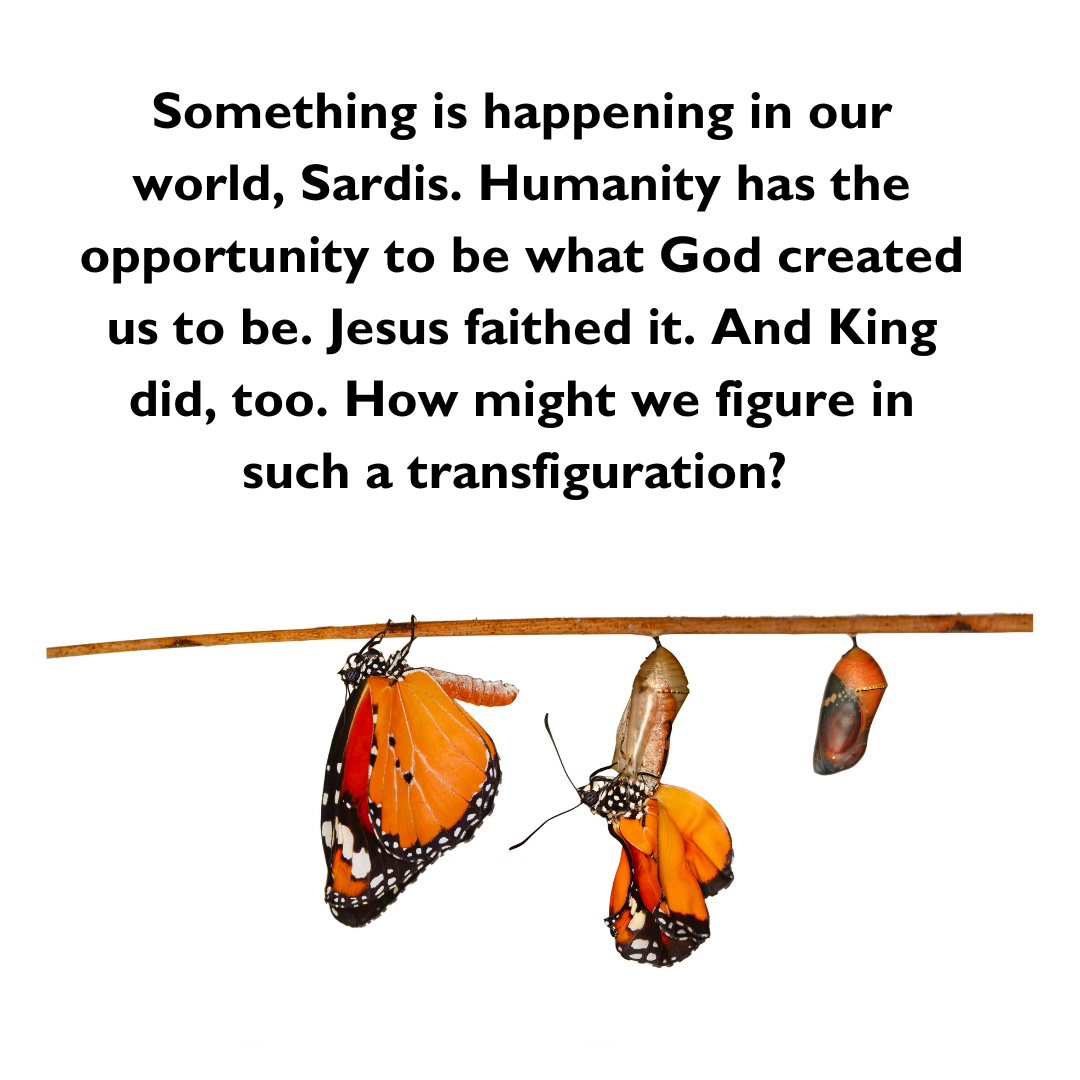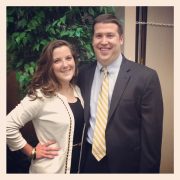Elevated Change

Elevated Change
Bob Stillerman
Transfiguration Sunday, 2/19/2023
Matthew 17:1-9
Elevated Change Matt 17.1-9 2-19-2023
This morning, in Matthew’s Gospel, we meet Jesus, Peter, James, and John as they climb a high mountain. It’s a strange story, but I suppose a likable one, too. Since at least as far back as the Ninth Century CE, Christians have celebrated some expression of the Feast of Transfiguration. In Protestant traditions, Transfiguration Sunday falls on the last Sunday of Epiphany.
Once more, this Sunday, we’re working from a text, and indeed a story, that we’ve engaged together multiple times. You know the drill. Jesus takes a few disciples with him on a hike. They reach the mountaintop, and the physical presence of Jesus is transformed – he beams a bright, Tide white. God affirms the work of Jesus. The prophets of old witness this, too. Peter, James, and John are terrified, not to mention a little confused. And when the scene is over, the four men descend the hill, and Jesus asks for their confidentiality.
This morning, I’m most interested in the idea of transfiguration. Transfiguration means to take on the appearance of transformation. It’s the end product of change. It’s a metamorphosis. It’s elevated or heightened change. Somebody or something is more than what it once was.
A baby learns to crawl and eventually walk. As she’s learning, she is changing. We see transformation in progress. Once she’s walking, she has transfigured – she stands upright; she takes on new motions. Her change is evident and visible, and that change is elevated.
I imagine Irena as someone who gets to see the shift from transformation to transfiguration on a regular basis. As beginners, her students learn to navigate the keys. Eventually, as they master a particular piece, their transcendence can be heard and felt in beautiful music. The moment of creating technically-perfect music, a kind of motionless movement, is a transfiguration.
Personally, I don’t believe Matthew’s description of Jesus’ transfiguration is all that important. Okay, so he turned bright white, and he glowed for a few days. His hair could have turned purple. He could have levitated. He could have become ten feet tall. He could have been taken on any characteristic your imagination can conjure up. It really doesn’t matter what the actual characteristic is.
Here’s what does: the author is seeking to convey to us, in a memorable way, that something substantive has happened in the life of Jesus. It’s been affirmed by God’s Spirit. It’s in keeping with Israel’s tradition. It’s going to change our world. Jesus isn’t simply ready to live out his calling; he’s elevating right in front of us; he’s meeting his purpose in this moment. Jesus has transfigured.
They say that Torah can be summarized in two simple statements: Do justice, love mercy, walk humbly. Love God and neighbor as you love yourself. There’s not a one of us in this room, nor was there anybody in Jesus’ circle who would disagree with the accuracy of those statements.
But knowing Torah, talking Torah, retaining Torah so well you can answer the Final Jeopardy! question isn’t the same as living Torah. We can only do justice, and love mercy, and walk humbly, and love God and neighbors as ourselves if we have faith – Faith in our Creator and faith in humanity.
Why faith in our Creator? If we do not believe that our source, our being, the creative spark that catapults us into existence has any value, how will we ever believe that we ourselves have value? I mentioned this last week – God tells Moses, and by extension the Israelites, and by extension all of us, “You, Children of God, have the power, the potential, and the giftedness to liberate yourselves from destructive systems and tendencies.” If we do not believe that God has created us as sacred and ever-capable of transcendence, then the collective wisdom and advice of our formal and informal canon isn’t gonna take us very far. We may win a gift certificate at pub trivia, but that knowledge is never gonna infuse our lives with impactful relationships. We must faith in the imagination of our God.
Why faith in humanity? Very simply we are connected. The systems of this world dare us to believe in the possibilities of our neighbors. The systems, in their haste to hoard power and resources, will lead us to believe that humanity has limited capacity – the average person can’t change; the average person can’t grow; the average person has no desire to cultivate empathy; the singular life is incapable of making a significant difference in this world.
I’ve been known to watch a little college basketball. Unfortunately, both games I watched this week featured the University of Virginia and Syracuse University. Wonderful schools. Proud programs. And traumatic and ugly basketball to watch if you root for the opponents of these schools. That’s because both schools employ defenses that dare the other team to settle for bad jump shots rather than work hard for good shots. By playing really good defense, these teams are betting that the other team won’t do the hard work of cooperation – passing, patience, finding open spots – to beat them. If our corporate lives were a basketball game, and our collective empathy was a jump shot, the systems of this world are betting that we are poor shooters.
But Torah, Sardis, Torah tells us that faithing in the potential of humanity isn’t a dare at all. God not only has the capacity to the transform the lives of God’s people, and God’s people the capacity to receive and reflect God’s transformation, but we’ve got a whole history to prove it. The great cloud of witnesses stretches the length of Israel’s unfolding story, and reminds us of God’s ever-present transformation and transcendence.
Jesus spends the first 16 chapters of Matthew building a relationship with Torah – he receives and shares its knowledge. He opens his heart, mind, and soul to new expressions. He uses his voice, his hands, and his feet building meaningful relationships with his neighbors. He heals. He teaches. He provides. He experiences humanity in its fullness. He learns to faith in God and humanity. And I would argue, that high atop a mountain, far across the sea, in a world separated from us by both space and time, Jesus expresses his full faith in God and humanity, and the collective capacity to usher in God’s inbreaking world.
And the only way Matthew’s author could think to describe the electricity of that fulfilled calling was to liken it to the transfiguring moments of prophets in bygone days.
I will admit, I struggle with the strangeness of this story. But I’ll also admit that our gospel authors had a hard assignment. How does one describe the power of a person living into their full humanity, seizing their purpose, and faithing in God’s potential? How do you describe the profound sense of peace combined with the terrifying sense of power? The disciples didn’t fear for their personal safety, but they were no less overwhelmed. “Can God really bestow this sense of calmness and peace, and can we really be witness to it?”
Jesus has reached a point in his life where he sees the world differently than most of us can imagine. He believes that God can transform his neighbors in the same way that he’s been transformed. And he believes that God not only can bring about this transformation, but that Got ultimately will bring about this transformation. Jesus doesn’t need immediacy to be convinced.
He’s nearly done with the Galilee portion of his ministry. He’s gonna go to Jerusalem. And he’s astute enough to know that there won’t be a warm welcome waiting for him. He knows that the systems are gonna keep playing that stingy zone defense. On that mountain, Jesus isn’t scared. He isn’t worried. He’s at peace because he believes in a future where Israel lives into its potential.
I can’t help but think of the sermon Martin Luther King, Jr. delivered the night before his assassination. It seems he shared a similar sense of peace and confidence. I’ve linked that sermon here. In it, King mentions that he wouldn’t choose to be a part of any other time in history.
I would turn to the Almighty, and say, “If you allow me to live just a few years in the second half of the twentieth century, I will be happy.” Now that’s a strange statement to make, because the world is all messed up. The nation is sick. Trouble is in the land. Confusion all around. That’s a strange statement. But I know, somehow, that only when it is dark enough, can you see the stars. And I see God working in this period of the twentieth century in a way that men, in some strange way, are responding–something is happening in our world. The masses of people are rising up. And wherever they are assembled today, whether they are in Johannesburg, South Africa; Nairobi, Kenya: Accra, Ghana; New York City; Atlanta, Georgia; Jackson, Mississippi; or Memphis, Tennessee–the cry is always the same–“We want to be free.”
It seems to me Sardis, our own transfigurations can only take place if we open ourselves to a new sense of wokeness.
Yes, by every means, we should inform ourselves of the systemic issues that inhibit our wholeness, and marginalize our neighbors. Awareness is crucial. But if all we want to do is be aware of injustice, and document it like Pharisees, we might as well go back to bed.
Instead, I wonder where we might find the curiosity to seek out the strange warming of hearts, especially in the neighbors who represent different ideas from our own. And I wonder how we might better train our hearts and minds to be open to the possibilities of their transformations and transfigurations as well? Must their movement be as quick and potent as Moses on a mountaintop? Or can it also have validity if it’s as clunky and bewildered as the disciples covered in cloud?
Something is happening in our world, Sardis. Humanity has the opportunity to be what God created us to be. Jesus faithed it. And King did, too. How might we figure in such a transfiguration?
Amen.
Recent Sermons
Palm Sunday 2025
April 13, 2025
Our Choices
April 06, 2025
Salvation Realized
March 30, 2025


